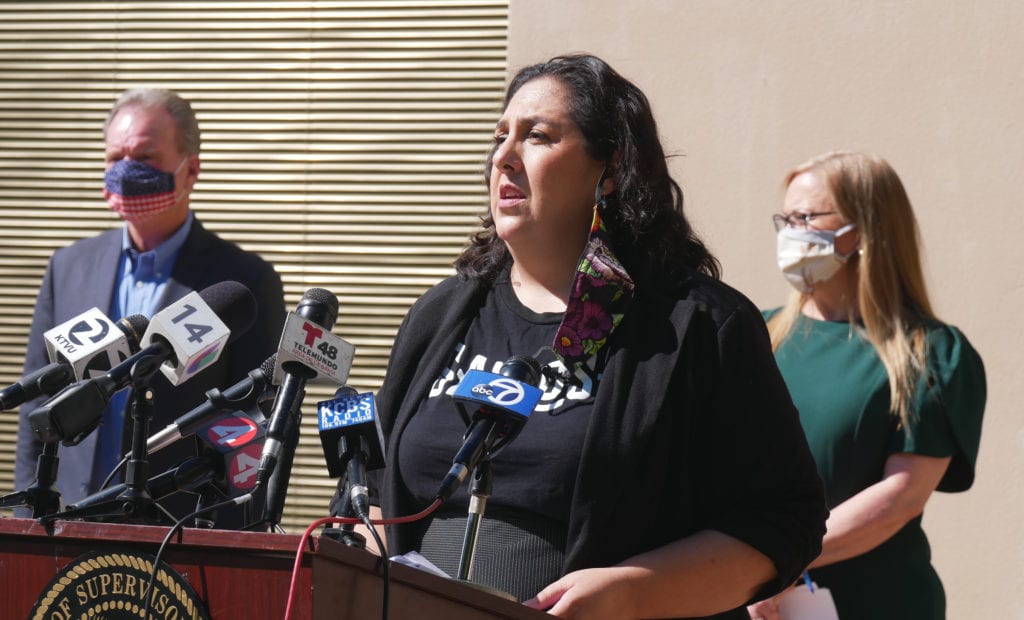A lack of access to technology and the internet meant Sylvandale Middle School teacher Brenna Rodriguez lost communication with 80% of her students when COVID-19 shuttered schools in March.
Teaching English and English Language Development within the Eastside’s Franklin-McKinley School District since 2008, Rodriguez said last year was the first time each of her students had access to a computer at school, with many completing assignments on smart phones at home.
Now as students’ bedrooms and kitchen tables transform into classrooms for distance learning, this lack of access is widening the gap of educational development as students, primarily in East San Jose, are falling behind other students who live in wealthier neighborhoods in Sunnyvale, Cupertino and Willow Glen, educators say.
“I’ve heard that it’s ‘one valley, two different worlds,’ and it’s very true,” Rodriguez said, noting access is drastically different between her step-daughter’s school in Sunnyvale and her family and students in East San Jose. “It should be equal – it is public education. There are major inequalities that are coming to light that those of us who have been in the public school system know firsthand.”
With 99% of her students having learned English as a second language, Rodriguez said tech fluency creates another barrier to learning, which many in Silicon Valley take for granted. She said she hopes these needs will be addressed as the COVID-19 pandemic changes how education is delivered for the foreseeable future.
“I suppose a silver lining of this pandemic is that people who have not even considered for a moment the lack of technological resources that teachers, students and families are working against are now starting to wake up and pay attention,” Rodriguez said. “I hope the greater Santa Clara County is starting to realize we all need to do something about this.”
Local lawmakers and school board members have recognized the need to get thousands of students online, with $7.1 million being dedicated Monday. These dollars will join $8.2 million previously set aside by San Jose Aug. 3 to help students with wireless internet hotspots and 4G LTE data plans.
Mary Ann Dewan, county superintendent of schools, said these combined funds will allow at least 15,000 under-connected students to pickvup laptops, tablets and Wi-Fi hotspots — basic tools necessary for distance learning and education in the 21st century.
This new traunch of money, alongside a $5 million commitment from San Jose CARES funds, means an additional $3.3 million will go toward hotspots, $2.2 will provide satellite internet and $6.6 million will provide 15,000 devices for students in kindergarten through 12th grade.
In announcing the additional funding, Dewan was joined by Santa Clara County Supervisors Cindy Chavez and Dave Cortese, as well as Juan Cruz, Franklin-McKinley School District Superintendent, and Maimona Afzal, the district’s board vice president.
In 2017, 28% of San Jose residents didn’t have home access to broadband, instead relying on free Wi-Fi and mobile phones, or dealing with no access at all. About 18% of families still lack access to the internet today.
San Jose Councilmember Maya Esparza, who previously served as a school board member for Franklin-McKinley School District, said that’s unacceptable for a city that considers itself to be the capitol of Silicon Valley.
“What was an obstacle before COVID has now become a crisis in a time where access to reliable internet is crucial for learning, searching for jobs, and many other things that most of us take for granted,” Esparza said. “As with many aspects of this pandemic, the worst effects of this digital divide impact low-income communities of color, which often sit in digital deserts.”


Councilmember Magdalena Carrasco echoed those concerns, calling this issue the “social justice issue of our time.” She said infrastructure is one key resource necessary in leveling the playing field between low-income and wealthy students as they all work to catch up from learning losses in the coming months.
“Now as we’re getting ready and geared up to start school, it is critical to make sure that they don’t just catch up, but that they thrive in one of the loveliest, richest regions in the world: Silicon Valley,” Carrasco said. “It is beholden upon us to make sure that we give them every tool possible, every opportunity necessary and every resource that is within our grasp to help them catch up and thrive.”
Contact Katie Lauer at [email protected] or follow @_katielauer on Twitter.



Leave a Reply
You must be logged in to post a comment.